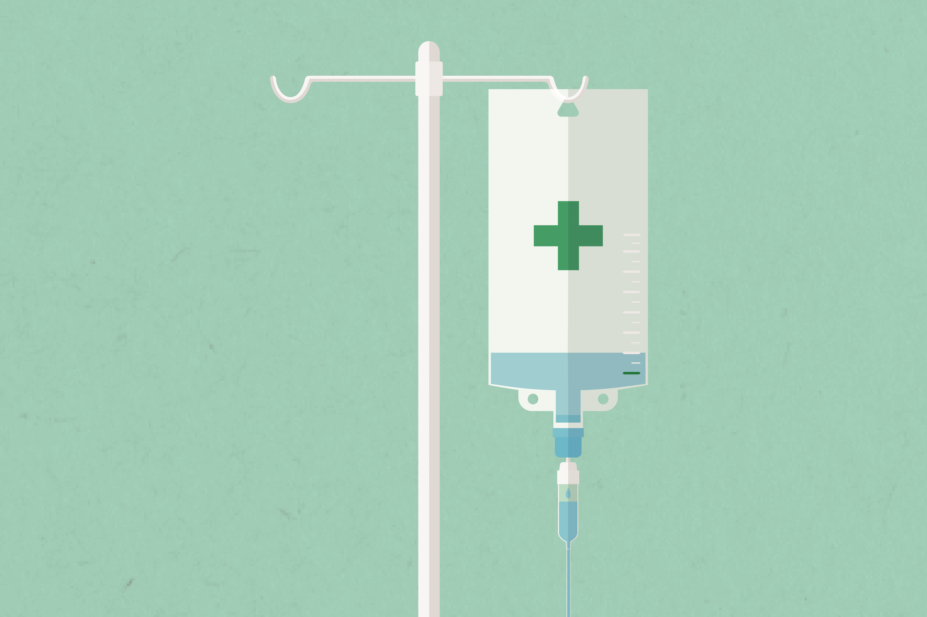
Shutterstock.com / JL
Current intravenous (IV) administration practices in NHS hospitals are putting patients at risk of undertreatment. Recent evidence suggests that when small-volume drug infusions are being administered, 10–20% of the prescribed dose may not be administered[1] — a statistic that should concern hospital pharmacists and others involved in the governance of injectable medicines and infusion systems.
Underdosing has clinical consequences. When antibiotic infusions are being administered to patients with sepsis, for example, underdosing will lead to lower antibiotic blood levels and less time within the minimum inhibitory concentrations. Similarly, patients who are being treated for epileptic fits with phenytoin infusion will have lower blood levels and time to reach the loading dose will be longer.
The current practice of administering small-volume infusions could be challenged in court as a breach of the Medicines Act 1968
The current practice of administering small-volume infusions could be challenged in court as a breach of the Medicines Act 1968, should a serious patient safety incident occur. Nursing staff who have a written instruction to administer the prescription — which specifies the dose and volume — could be questioned on why they administered only 80–90% of the prescribed dose, when it is perfectly possible to administer the full dose by flushing the administration set.
This situation has arisen following a change from the previous method used to administer small-volume drug infusions, which involved a primary administration set attached to a large-volume clear solution infusion (for example, sodium chloride 0.9%), and a much shorter secondary set used to administer the small-volume drug infusion. The secondary set was connected to a third from the top of the primary set, and the small infusion was hung above the primary solution. Once the secondary infusion had been completed, the primary infusion automatically flushed any drug remaining in the primary infusion set into the patient.
The use of a separate primary administration set for small-volume drug infusions gradully came into practice over the past 10–15 years because it is cheaper
But the current use of a separate primary administration set for small-volume drug infusions gradually came into practice over the past 10–15 years, possibly because it is cheaper. The separate primary administration sets are much longer than secondary sets and retain more drug infusion, so they should be flushed with sodium chloride 0.9%, or a compatible solution, to administer the full prescribed dose.
Evidence for underdosing
Cooper et al. sought to determine the scale of the problem of discarded medicine in IV infusions sets in a large NHS teaching hospital and their research revealed that 74% of administration sets were not flushed over the seven-day study period[1]
. Non-flushing exceeded 90% and 61% for gravity and pump infusions, respectively (P <0.001) in all areas except oncology. Oncology was the only area in which flushing was standard practice for all infusions (P <0.001). Mean residual volume of the administration sets was 13.1mL and 16.7mL for gravity and pump sets, respectively. Up to 21% of antibiotic doses was discarded. The authors concluded the need for clear national and local policies.
Meanwhile, Furniss et al. looked into procedural and documentation variations in IV infusion administration across 16 hospital trusts in England and found a 47.9% rate of deviation from procedural or documentation requirements[2]
. Focus groups revealed lack of policy awareness, ambiguous policies, safety and practicality concerns, different organisational priorities, and wide variation in policies and practice relating to prescribing and administration of IV flushes and double-checking.
There is very little national guidance in the UK on how to accurately and safely administer small-volume infusions and the need to flush intravenous administration sets
The authors concluded that the ‘Patient Safety Alert 20’ — on the safer use of injectable medicines issued by the then National Patient Safety Agency in 2007[3]
— highlighted the importance of “designing adequate and pragmatic procedures for IV safety”, but, that ten years on from the alert’s publication, their study is the first to investigate the state of IV infusion administration policy and practice in England. The authors describe “a widening gap between work-as-imagined (policies) and work-as-done (practices)” and call for “more national guidance and standardisation … to help trusts devise appropriate IV infusion policies”.
UK infusion resources are inadequate
In the United States, the primary and secondary set ‘piggy-back’ system is still used to administer small-volume infusions; US-based Thoele et al. have published information on how to administer small amounts of infusion retained in secondary sets to ensure the full prescribed dose is administered[4]
. But there is very little national guidance in the UK on how to accurately and safely administer small-volume infusions and the need to flush IV administration sets.
The section in the British National Formulary entitled ‘Guidance on intravenous infusions’ includes information on intermittent infusions, but describes only older and less frequently used administration systems, such as burette and primary and secondary sets. The section does not describe the use of separate administration sets for these infusions and the importance of flushing these sets to ensure the prescribed dose is actually administered[5]
.
There is no information on ensuring full infusion doses and flushing in the Royal College of Nursing’s ‘Standards for infusion therapy’[6]
or the Medicine and Healthcare products Regulatory Agency’s guidance on ‘Infusion systems’[7]
.
The Marsden Manual of Clinical Nursing Procedures includes a section (12.25) on ‘Medication: intermittent infusion of intravenous drugs’, which recommends health professionals to “disconnect the infusion set and flush the device with 10mL of 0.9% sodium chloride or other compatible solution for injection”[8]
.
The manual advises that “a ‘minibag’ may be used to flush the drug through the tubing” but says that “the cost implications of this as well as the risk to patients on restricted intake should be considered before this is adopted routinely”. The authors state that the rationale behind this practice is “to flush any remaining irritating solution away from the cannula”[8]
.
The Marsden Manual fails to recognise the need to administer the full dose prescribed as a rationale for flushing the administration set and it is inappropriate to base the decision on whether to flush the administration set and administer the full prescribed dose on the basis of cost. There are no circumstances in which it is acceptable to underdose the patient by 10–20% to save money.
Learning from other health systems
In June 2015, the Bundesinstitut für Arzneimittel und Medizinprodukte — the German medicines and medical devices regulator — issued a drug safety bulletin which advised that if the loss of active substance in the residual volume exceeds 5–10%, the efficacy of the medical drug might be reduced[9]
. This threshold will be exceeded whenever short-term infusions with small volumes (<100mL) are administrated. For most medicinal drugs, a loss of active substance must also not be neglected in case of volumes up to 200mL. Flushing the infusion system with an appropriate flushing solution at a constant flow rate is required. The effect of the residual volume can also be reduced by switching to infusion systems that have lower priming volumes, or by increasing the total volume of the infusion by dilution.
Calling for guidance
I have written to the editors of UK infusion guidance publications to raise the issue of incomplete infusions and underdosing — I have requested that they update their guidance at the earliest opportunity.
I have also written to the patient safety team at NHS Improvement, the Nursing and Midwifery Council, and the chief inspector of hospitals at the Care Quality Commission, to inform them of this risk and to request action to improve patient safety.
As a way forward, I suggest that NHS Improvement issues a patient safety alert, which would raise awareness of this risk in the NHS, and direct staff to updated national guidance and local procedures to assist them in administering small-volume drug infusions more accurately and safely.
Hospital pharmacists should review written procedures and practices for administering small-volume infusions in their own organisation and — working in multidisciplinary teams — take the necessary action to clarify and improve practice to ensure patient safety.
David Cousins, independent safe medication practice consultant; former head of safe medication practice, National Patient Safety Agency and NHS England
The British National Formulary, the Royal College of Nursing and the Medicines and Healthcare products Regulatory Agency are reviewing their guidance on intravenous infusions. The editors of the
Marsden Manual of Clinical Nursing Procedures
were contacted for comment.
A spokesperson for NHS Improvement said:
“We encourage patients and staff to report patient safety issues so that we can help the NHS improve. All feedback and issues raised to us — through correspondence, the National Reporting and Learning System, or other routes — are carefully considered so that appropriate action is taken to help stop the same thing from happening to someone else. We will continue to work closely with the NHS to ensure patients receive the best care possible.”
References
[1] Cooper DM, Rassam T & Mellor A. Non-flushing of IV administration sets: an under-recognised under-dosing risk. Br J Nurs 2018;27(14):S4–S12. doi: 10.12968/bjon.2018.27.14.S4
[2] Furniss D, Lyons I, Dean Franklin B et al. Procedural and documentation variations in intravenous infusion administration: a mixed methods study of policy and practice across 16 hospital trusts in England. BMC Health Serv Res 2018;18(1):270. doi: 10.1186/s12913-018-3025-x
[3] Specialist Pharmacy Service. Archived NPSA alert — Promoting safer practice with injectable medicines (NPSA 20) 2007. Available at: https://www.sps.nhs.uk/articles/npsa-alert-promoting-safer-use-of-injection-medicines-npsa-20-2007 (accessed December 2018)
[4] Thoele K, Piddoubny M, Ednalino R et al. Optimizing drug delivery of small-volume infusions. J Infusion Nurs 2018;41(2):113–117. doi: 10.1097/NAN.0000000000000268
[5] Joint Formulary Committee. British National Formulary: Guidance on intravenous Infusions. 75th ed. London: BMJ Group and Pharmaceutical Press
[6] Royal College of Nursing. Standards for infusion therapy. 4th ed. 2016. Available at: https://www.rcn.org.uk/professional-development/publications/pub-005704 (accessed December 2018)
[7] Medicines and Healthcare products Regulatory Authority. Infusion systems. 2013. Available at: https://assets.publishing.service.gov.uk/government/uploads/system/uploads/attachment_data/file/403420/Infusion_systems.pdf (accessed December 2018)
[8] Dougherty L, Lister S and West-Oram A (eds). The Royal Marsden Manual of Clinical Nursing Procedures. 9th ed. 2015. The Royal Marsden NHS Foundation Trust. 2015. ISBN: 978-1-118-74592-2
[9] Bundesinstitut für Arzneimittel und Medizinprodukte, Paul Erhlich Institute. [Drug safety bulletin: The forgotten residue — dead volumes in short term infusions]. 2015. Available at: https://www.bfarm.de/SharedDocs/Downloads/DE/Arzneimittel/Pharmakovigilanz/Bulletin/2015/2-2015.pdf?__blob=publicationFile&v=3 (accessed December 2018)

